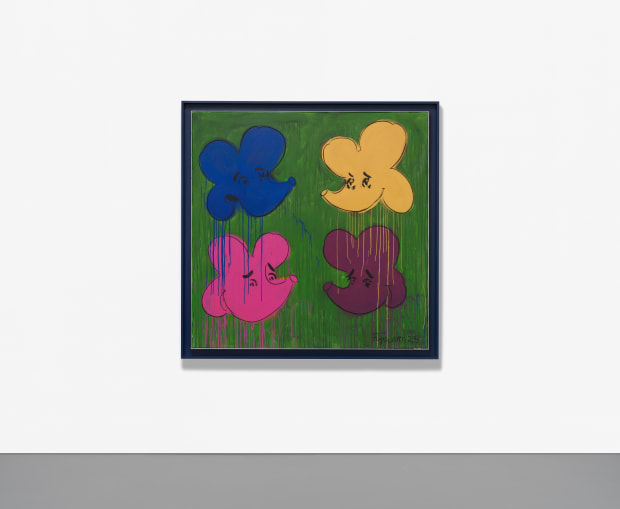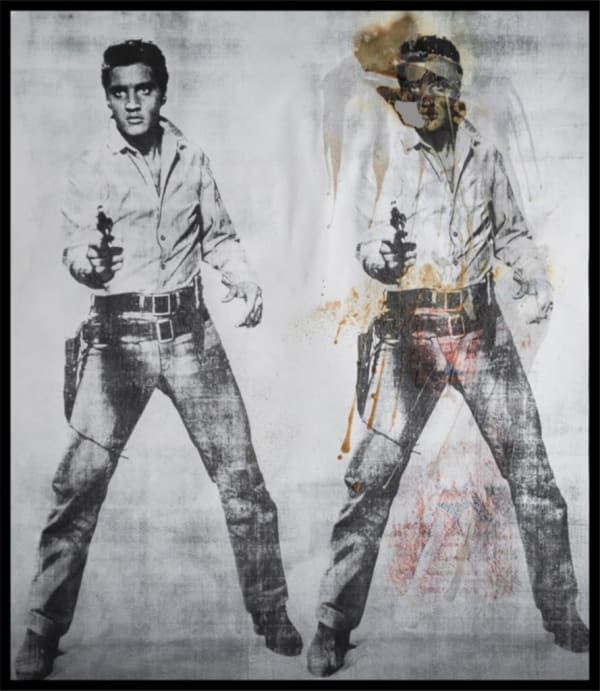Dvir / Paris
Gallery Hours
Tuesday – Thursday: 11:00 – 19:00
Friday – Saturday: 12:00 – 19:00

Simon Fujiwara born 1982, London, England. Lives and works in Berlin, Germany.
Fujiwara’s work takes multiple forms including wax figures, robotic cameras, ‘make-up’ paintings and short films that address the complexity and contradictions of identity in a post-internet, hyper-capitalist world. The artist often investigates themes of popular interest such as tourist attractions, famous icons, historic narratives and mass media imagery and has collaborated with the advertising and entertainment industries to produce his work in a process he describes as ‘hyper-engagement’ with dominant forms of cultural production. Fujiwara’s work can be seen as a complex response to the human effects of image fetish, technology and social media on his generation. In 2022, Simon Fujiwara introduced to the world ‘Who the Bær,’ an original cartoon character that inhabits a fantasy universe created by the artist and infiltrates various art-world images and masterpieces from art history. Fujiwara had numerous solo exhibitions, among others, at KIAMSA (Helsinki), the Fondazione Prada (Milano), Blaffer Art Museum (Houston, TX), Kunsthalle Düsseldorf (Düsseldorf), Tokyo Opera City Art Gallery (Tokyo). He was part of various group exhibitions, including in the MAXXI (Rome), Solomon R. Guggenheim Museum (New York City), Musée national d’Art Moderne — Centre Georges Pompidou (Paris), Hamburger Bahnhof (Berlin). Fujiwara has been shortlisted for the Preis der Nationalgalerie at Hamburger Bahnhof. His works are part of numerous prestigious collections including The Tate Collection, London; MoMa, New York; Solomon R. Guggenheim Museum, New York; Sammlung Verbund, Vienna; The Israel Museum, Jerusalem; Galeries Lafayette, Paris; The Prada Collection, Milan amongst others.

Who the Baer was developed by the artist during the first pandemic lockdown as a ‘Dada-esque response to an increasingly absurd and incomprehensible world.’ Fujiwara’s character takes the form of an identity-free cartoon bear named ‘Who’ that moves through a hyper-mediated, image-obsessed world in search of a true self. With seemingly no race, no gender and no sexuality, ‘Who’ is only recognizable by their white fur, golden heart and impossibly long tongue. Doomed to forever be ‘only 2 dimensional’ and trapped in their status as an image, ‘Who’ poses earnest questions on the nature of a ‘true and authentic self’ in an era of hyper technological mediation. ‘Who’ has the unique ability to shapeshift and perform any identity they wish. Will ‘Who’ ever find a true, authentic self? For a cartoon character, isn’t it enough to simply appear to be authentic? Fujiwara reshape and reinvent 20th century masterpieces through the lens of Who the Baer and explore themes from gender identity and image culture to internet dating and cultural appropriation. Working though the canon of Western art historical icons - from Picasso and Matisse to Basquiat and Warhol - Fujiwara’s Who the Baer pastiche paintings and collages invites audiences on a journey through 20th century art history. Presented as a fairy tale of endless possibilities, the works shed light on the philosophical struggle of Who the Baer as they transform endlessly in their restless desire just to ‘be’. Since its debut in 2021 at the Fondazione Prada in Milan, exhibitions of Fujiwara’s acclaimed series Who the Bær have travelled to Kunstinstituut Melly, Rotterdam and Prada Aoyama, Tokyo and KIASMA, Helsinki. The series has also been presented across multiple media, from painting and sculpture, full scale installations, stop frame animations and a children’s book, to a Whotique – a boutique of Who the Bær – that produces merchandise by ‘Who’ and has collaborated with world-renowned fashion labels. Who the Bær can also be followed via their official Instagram account: @whothebaer


Douglas Gordon born 1966, Glasgow, Scotland. Lives and works in Berlin, Glasgow and Paris.
Gordon’s practice encompasses video, film, installation, sculpture, photography and text. Through his work, the artist investigates human conditions of memory, passage of time, ambiguity and the disruption of the normal as well as the binary nature and the tendency to split things into opposites: black / white, good / evil.
He won the Turner Prize in 1996, the Premio 2000 at the 47th Venice Biennale in 1997 and the Hugo Boss Prize in 1998.
Gordon’s work has been exhibited globally, in major solo exhibitions including: the Museum of Modern Art in New York, USA; TATE Britain in London, UK; Musée d’Art moderne de la Ville de Paris, France; ARoS Aarhus Art Museum in Denmark; Dunedin Public Art Gallery in New Zealand; Prisons of the Palazzo Ducale in Venice, Italy; K20, Kunstsammlung Nordrhein-Westfalen in Düsseldorf, Germany; the Tel Aviv Museum of Art in Israel; the National Gallery of Scotland in the UK; the Hayward Gallery in London, UK; as well as the MOCA in Los Angeles and the Neue Nationalgalerie in Berlin, Germany. His film works have been invited to the Festival de Cannes, Toronto International Film Festival (TIFF), Venice Film Festival, Edinburgh International Film Festival, BFI London Film Festival, Festival del Film Locarno, New York Film Festival, among many others.

Douglas Gordon self-portraits’s allude to uneasy affinity for Andy Warhol, which has often impacted the content and tone of his work. Warhol’s immortalized cultural icons as charred here, with browned bits of commercial reproductions floating on mirrored on backgrounds. These are singed remnants of the heroic originals that nonetheless possess an eerily powerful presence. Douglas Gordon’s portraits underscore Warhol’s phenomenal resonance in today’s art world, while capturing the self-reflexive nature of the post-Warholian period.









‘Metallic Sunset with additional Information’, is formed by a single image of the Sunset Boulevard in which each piece is combined with different objects, the combination is made in a associative way with a wink to art history to the likes of artist like Haim Steinbach’s Mike Kelley.

“For ‘The Deflated Inflated’, Jonathan Monk turns his attention to neo-pop artist Jeff Koons. In 1987 – incidentally the same year that Monk began art school in Glasgow – Charles Saatchi first introduced Koons’ work to a British audience, by including ‘Rabbit’ (1986) in the two-part exhibition New York Art Now. The sculpture, a larger than life cast in stainless steel of a toy bunny inflatable balloon, has become an icon of its era and its highly polished surface has fuelled imitations and tributes, such as Mark Leckey’s film ‘Made in ‘Eaven’ (2004). Starting from a pink vinyl inflatable bunny, Koon’s original source, Monk has created a sequence of stainless steel sculptures, which capture the inflatable in progressive states of deflation. With each stage, the ‘Deflated Sculpture’ (2009) droops slightly, leans against the wall of the exhibition space, folds over and collapses in a formless shape on its own plinth. As Koons raised everyday mundane objects to iconic status, Monk literally deflates this monumentality using a characteristic whimsical twist and a wink to Claes Oldenburg’s soft sculptures.”
The ‘Exhibit Model Details with Additional Information’ are installation views of former exhibitions. Three-dimensional artwork editions and everyday objects belonging to popular culture are added to the photographic support, makinga new collage/composition opening up for new interpretations. Several time periods and sensations are presented simultaneously and overlap each other. According to the artist: ’This particular series of works does (kind of) feed from itself. Images of them installed may even become wallpaper within the Exhibit Model series and they potentially become part of this series again, vanishing into the documentation of documentation.


* denotes required fields
We will process the personal data you have supplied in accordance with our privacy policy (available on request). You can unsubscribe or change your preferences at any time by clicking the link in our emails.
Dvir / Paris
Gallery Hours
Tuesday – Thursday: 11:00 – 19:00
Friday – Saturday: 12:00 – 19:00
Dvir / Tel Aviv
Shvil HaMeretz 4, 2nd floor
Tel Aviv-Yafo, Israel
Gallery Hours
Thursday: 10:00 – 17:00
Friday – Saturday: 10:00 – 14:00
And by appointment
Dvir / Brussels
T. +32 486 54 73 87
This website uses cookies
This site uses cookies to help make it more useful to you. Please contact us to find out more about our Cookie Policy.